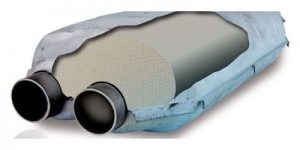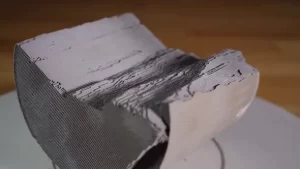Ceramic catalysts
 Ceramic catalysts made from a cordierite base are usually installed between the engine and the exhaust pipe. The main metal component of the honeycomb structure is, for example, oxides. The carrier also contains rare metal oxides such as La2O3. These compounds perform ancillary functions. The working part of the catalysts is finely porous, in the form of a honeycomb, so that the active substance with a large surface area is contained in a small volume. The honeycomb walls are coated with a support containing active catalyst particles. Analysis of used car catalysts for the determination of the precious metals platinum (Pt), palladium (Pd) and rhodium (Rh).
Ceramic catalysts made from a cordierite base are usually installed between the engine and the exhaust pipe. The main metal component of the honeycomb structure is, for example, oxides. The carrier also contains rare metal oxides such as La2O3. These compounds perform ancillary functions. The working part of the catalysts is finely porous, in the form of a honeycomb, so that the active substance with a large surface area is contained in a small volume. The honeycomb walls are coated with a support containing active catalyst particles. Analysis of used car catalysts for the determination of the precious metals platinum (Pt), palladium (Pd) and rhodium (Rh).
 The catalyst reduces the activation energy of the reaction, so that chemical reactions that do not normally occur can take place with the help of the catalyst. The catalyst accelerates both direct and reverse reactions without shifting the equilibrium. It is essential to maintain the necessary conditions for thermodynamics in order not to disturb the balance and the environmental conditions guaranteeing stability. In order to get the most efficient converter, it is necessary to increase the effective surface to the maximum value. The latter increases the number of reduction / oxidation processes to the maximum possible value and ensures excellent catalyst performance. As the surface is dynamic, it is necessary to take into account the wear conditions, the formation of additional chemical compounds, the absorption and adsorption of the exhaust gas molecules. As a result, additional tensioning forces may occur that interfere with the proper operation of the converter
The catalyst reduces the activation energy of the reaction, so that chemical reactions that do not normally occur can take place with the help of the catalyst. The catalyst accelerates both direct and reverse reactions without shifting the equilibrium. It is essential to maintain the necessary conditions for thermodynamics in order not to disturb the balance and the environmental conditions guaranteeing stability. In order to get the most efficient converter, it is necessary to increase the effective surface to the maximum value. The latter increases the number of reduction / oxidation processes to the maximum possible value and ensures excellent catalyst performance. As the surface is dynamic, it is necessary to take into account the wear conditions, the formation of additional chemical compounds, the absorption and adsorption of the exhaust gas molecules. As a result, additional tensioning forces may occur that interfere with the proper operation of the converter
 Catalytic converters usually have two ways to reduce the harmfulness of exhaust fumes. The exhaust gases are first reduced to break down the parent chemicals, after which the molecules are oxidized to give the final products, the emissions. The latter have a markedly reduced toxicity to the parent compounds. The most modern cars are equipped with a new generation of 3-component catalysts: consisting of two monolithic blocks. The former performs reduction reactions, and the surface of this catalyst is usually coated with platinum (Pt) and rhodium (Rh) islets. These precious metals accelerate chemical reactions up to 10 times. The second block performs oxidation reactions, the latter being coated with platinum (Pt) and palladium (Pd) islets
Catalytic converters usually have two ways to reduce the harmfulness of exhaust fumes. The exhaust gases are first reduced to break down the parent chemicals, after which the molecules are oxidized to give the final products, the emissions. The latter have a markedly reduced toxicity to the parent compounds. The most modern cars are equipped with a new generation of 3-component catalysts: consisting of two monolithic blocks. The former performs reduction reactions, and the surface of this catalyst is usually coated with platinum (Pt) and rhodium (Rh) islets. These precious metals accelerate chemical reactions up to 10 times. The second block performs oxidation reactions, the latter being coated with platinum (Pt) and palladium (Pd) islets


